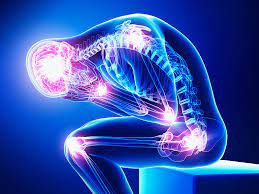February 7, 2025 – A new study published in JAMA Neurology has revealed a significant association between headache disorders—including migraine, tension-type headache, trigeminal autonomic cephalalgia (TAC), and posttraumatic headache—and both attempted and completed suicide. The large-scale study found that individuals with posttraumatic headache faced more than three times the risk of attempting or completing suicide compared to those without headache, while those with TAC had more than double the risk.
Even tension-type headaches, often considered a milder form of headache, carried nearly a twofold increased risk for attempted suicide, highlighting the importance of recognizing the mental health impact of headache disorders.
The Scope of the Study
Conducted using Danish population-based medical and administrative registries from 1995 to 2020, the study analyzed data from 7.9 million individuals. The headache cohort consisted of 119,486 individuals matched with 597,430 individuals without headache. The study’s follow-up period averaged 8.7 years.
Lead researcher Dr. Holly Elser, MD, MPH, PhD, a resident physician at the University of Pennsylvania’s Department of Neurology, described the findings as “striking,” underscoring the need for mental health screening even among patients with milder headache types.
The data revealed that individuals with headache disorders were twice as likely to attempt suicide (adjusted hazard ratio [aHR] 2.04) and 1.4 times more likely to die by suicide (aHR 1.40) compared to those without headache.
Breaking Down the Risk by Headache Type
The study found that different headache types carried varying levels of suicide risk:
- Posttraumatic headache had the highest risk, with a threefold increase in both attempted (aHR 3.14) and completed suicide (aHR 3.22).
- Trigeminal autonomic cephalalgia (TAC) was associated with more than twice the risk of completed suicide (aHR 2.40).
- Tension-type headache, while often considered mild, still carried a significantly increased risk for attempted suicide (aHR 1.91).
Additionally, the setting in which a patient was diagnosed with a headache also influenced suicide risk:
- Those diagnosed in an inpatient hospital setting had a 2.70 times higher risk of attempting suicide.
- Emergency department diagnoses carried a 2.27 times higher risk.
- Outpatient diagnoses showed a 1.57 times higher risk.
Understanding the Link Between Headache and Suicide
While the precise mechanisms remain unclear, researchers believe multiple factors may contribute to the link between headache disorders and suicidality. The bidirectional relationship between headache and psychiatric comorbidities, including depression and anxiety, may exacerbate headache severity and frequency. Additionally, chronic pain has been consistently associated with increased suicidality, and biological mechanisms such as disruptions in serotonin pathways and inflammatory cytokines may further contribute to both headache disorders and psychiatric symptoms.
Dr. Fred Cohen, MD, a neurology professor at the Icahn School of Medicine at Mount Sinai, who was not involved in the study, emphasized the need for routine mental health screening among headache patients. “These conditions are often dismissed as ‘just headaches,’ but they are much more complex and debilitating,” he noted. “Depression screenings should be standard practice when evaluating patients with headaches.”
Call for Greater Awareness and Early Detection
The study’s findings highlight the critical need for early detection of depressive symptoms and suicidal thoughts in patients suffering from headache disorders. Dr. Elser stressed that patients with headaches and psychiatric symptoms may particularly benefit from comanagement with behavioral health specialists.
Despite its significant findings, the study has some limitations, including reliance on diagnosis codes, which could lead to misclassification, and a lack of data on headache severity and chronicity.
Conclusion
Given that headache disorders affect approximately 67% of the global population, they remain a leading cause of productivity loss, disability, and absenteeism. This study sheds light on an often-overlooked aspect of headache disorders—their potential to increase suicide risk.
Healthcare professionals are encouraged to integrate mental health screenings into headache management to identify at-risk individuals and provide timely interventions.
Disclaimer: This article is for informational purposes only and does not constitute medical advice. If you or someone you know is struggling with suicidal thoughts, seek professional help or contact a crisis helpline immediately.












